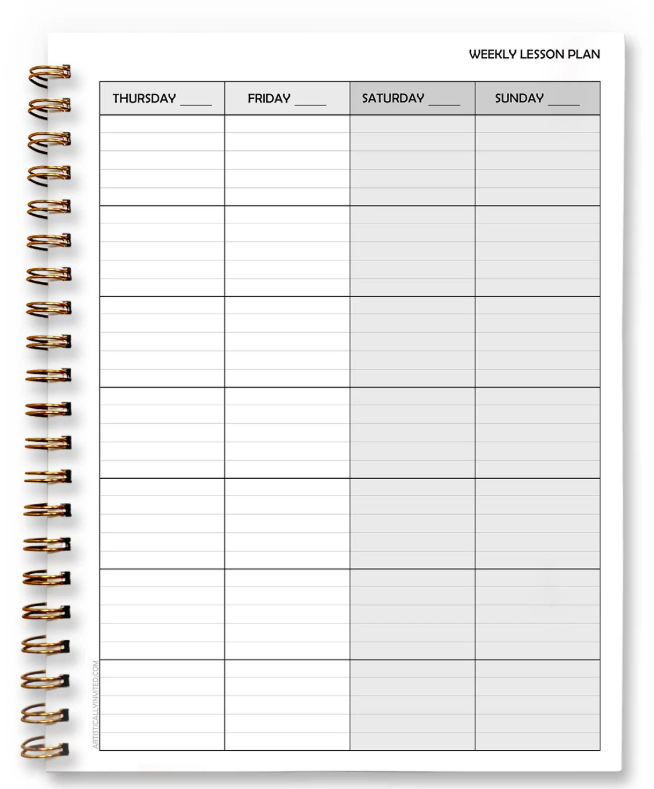Free Undated Daily Lesson Plan Printables – Easy!
The term identifies resources designed to aid educators in organizing their instructional activities for each day. These resources, typically in a digital document format, are structured templates that lack pre-assigned dates, offering flexibility in their use. An example would be a downloadable PDF document containing blank tables for lesson objectives, activities, materials, and assessments, which the teacher fills in according to their specific schedule and curriculum.
The significance of these materials lies in their adaptability and cost-effectiveness. Their format allows educators to customize their lesson schedules to fit unique classroom needs, differing school calendars, or variations in curriculum pacing. The absence of pre-printed dates prevents obsolescence, enabling long-term use. Historically, educators relied on commercially printed planners. These digital templates represent a shift towards personalized, readily accessible, and environmentally conscious planning solutions, reducing reliance on physical resources.
Considering the advantages, a more detailed examination of their characteristics, the diverse formats available, strategies for effective utilization, and guidance on selecting or creating appropriate templates is warranted. These factors will contribute to a more comprehensive understanding of the options available for lesson management.
Frequently Asked Questions
This section addresses common inquiries regarding the selection, use, and benefits of freely available, undated daily lesson planning templates.
Question 1: What advantages do undated templates offer over dated, pre-printed lesson planners?
Undated templates provide flexibility, allowing educators to customize planning according to specific school calendars, curriculum changes, or individual teaching styles. They avoid the limitations of fixed dates and prevent obsolescence due to unused pages.
Question 2: What are the most common file formats for these templates, and what software is required to use them?
Common formats include PDF, DOCX (Microsoft Word), and spreadsheets. PDF files generally require a PDF reader, while DOCX files necessitate a compatible word processor. Spreadsheet files typically need spreadsheet software.
Question 3: How can one ensure the selected template aligns with specific pedagogical approaches?
Careful review of the template’s layout and sections is essential. Consider whether the template includes spaces for learning objectives, differentiated instruction, assessment strategies, and reflection notes, as needed.
Question 4: Are there any legal considerations when utilizing freely available templates downloaded from the internet?
It is crucial to verify the licensing terms of each template. Ensure the license allows for educational use and modification. If unclear, contacting the template provider for clarification is advisable.
Question 5: How can the effectiveness of these templates be evaluated and improved?
Regularly review the template’s utility in practice. Gather feedback from students and colleagues regarding its clarity and usefulness. Modifications can then be made to optimize its design for specific classroom needs.
Question 6: What strategies can be implemented to organize and store numerous digital planning templates effectively?
Develop a consistent file naming convention and folder structure for templates. Utilize cloud storage solutions for accessibility and backup. Employ metadata tagging to facilitate searching and retrieval.
In summary, these freely available resources offer a versatile means of organizing daily instruction, contingent upon careful selection, appropriate utilization, and adherence to relevant legal considerations.
The following section will delve into specific template designs and their optimal applications in diverse educational settings.
Optimizing Undated Daily Lesson Planning Resource Utilization
The following guidance aims to maximize the effectiveness of freely accessible, undated daily lesson planning resources in educational settings. Implementing these strategies can streamline the planning process and enhance instructional delivery.
Tip 1: Customization for Specific Needs: Adapt templates to align with individual teaching styles and subject matter requirements. Generic templates may lack sections relevant to specific disciplines or pedagogical approaches. Tailoring the template ensures all essential elements are included.
Tip 2: Consistent Template Application: Establish a standardized format for all lesson plans. Uniformity facilitates easier review, collaboration with colleagues, and tracking of instructional progress. Consistency promotes efficiency and clarity.
Tip 3: Integration of Assessment Strategies: Incorporate dedicated sections for formative and summative assessment planning. Specify methods for evaluating student learning and identify data collection strategies to inform future instruction.
Tip 4: Utilization of Digital Collaboration Tools: Employ cloud-based storage and sharing platforms to facilitate collaborative planning with co-teachers or instructional teams. This promotes consistency in curriculum delivery and provides a mechanism for peer review and feedback.
Tip 5: Periodic Template Evaluation and Revision: Regularly assess the efficacy of the chosen template. Gather feedback from students and colleagues to identify areas for improvement. Modify the template to reflect evolving instructional needs and best practices.
Tip 6: Prioritization of Key Learning Objectives: Clearly define measurable learning objectives for each lesson. Emphasize alignment between objectives, activities, and assessments to ensure a cohesive and purposeful learning experience.
Tip 7: Incorporation of Differentiation Strategies: Dedicate sections for planning differentiated instruction to meet the diverse needs of learners. Specify modifications to content, process, product, or learning environment to accommodate varying learning styles and levels.
Adherence to these tips promotes structured and effective lesson planning, leading to enhanced instructional outcomes and improved student learning experiences. These strategies emphasize thoughtful adaptation, consistency, and ongoing evaluation to maximize the benefits derived from readily available planning templates.
The subsequent discussion will address the practical considerations involved in locating and accessing appropriate planning resources.
Conclusion
The exploration of undated daily lesson planning free printables reveals their significance as adaptable tools for educators. Their inherent flexibility allows for customization according to diverse curricula, schedules, and pedagogical approaches. The absence of pre-assigned dates provides a sustainable and cost-effective solution for organizing instructional activities, moving away from rigid, pre-printed alternatives.
The judicious application of these resources requires careful template selection, consistent implementation, and periodic evaluation to ensure alignment with specific teaching contexts. Educators are encouraged to critically assess available templates and to tailor them to meet the unique needs of their students and subject matter, fostering a more effective and personalized learning environment. The continued evolution and refinement of these planning resources hold the potential to further enhance the quality and efficiency of instructional design.
